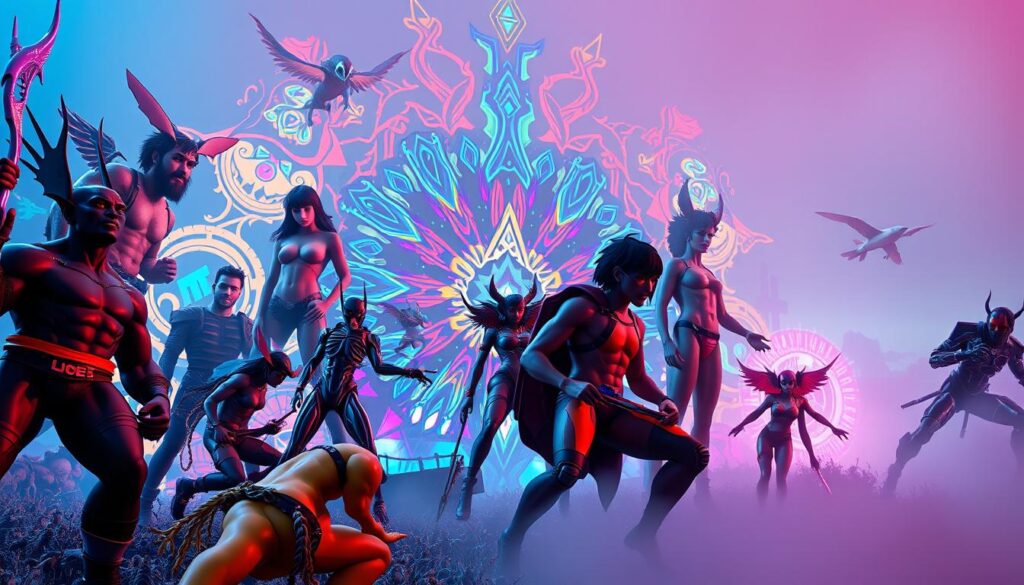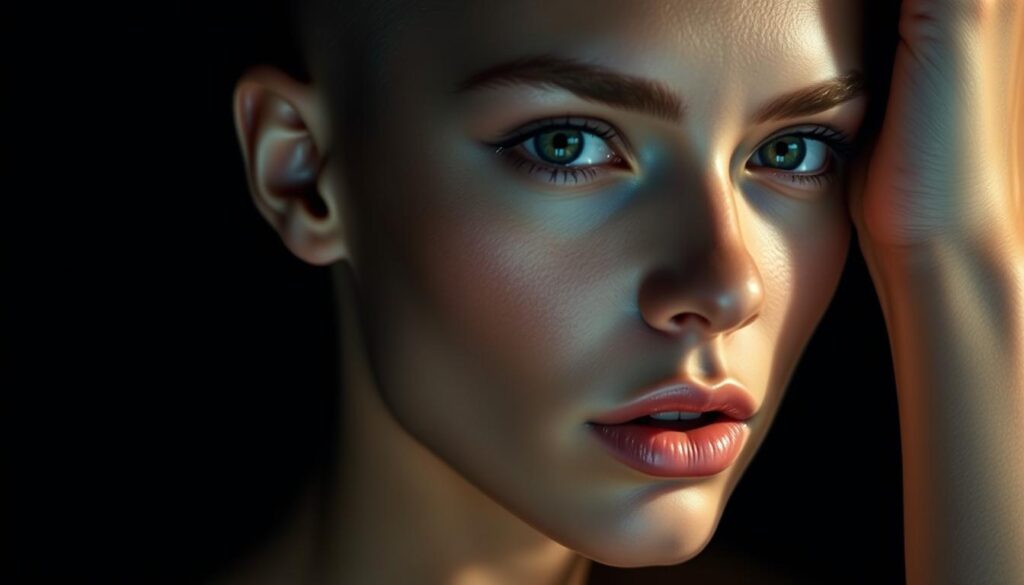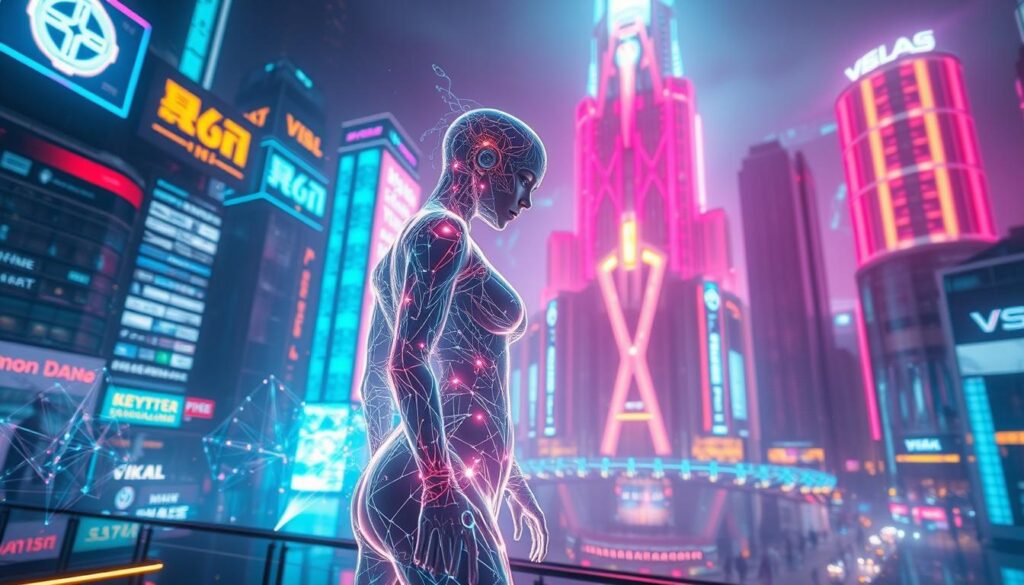7 Bold AI Futa Art Trends You’ll Find Fascinating in 2025
14 min read
Table of Contents
Can artificial intelligence really be creative, or is it just a tool for artists? The digital art world is changing fast. AI-generated art is now a big part of it.
AI Futa Art mixes technology with art, changing our view of what art is. We’ll see how futurism is making art different.

We’re going to explore the exciting world of AI-generated art. We’ll look at trends that are changing this field. With new techniques and ways to express art, the future looks bright.
The Evolution of AI-Generated Art in Digital Spaces
The digital art scene is evolving quickly with the rise of new tech tools. This change brings new and exciting ways to create art. Thanks to big steps in technology and machine learning, artists can now make complex and beautiful works.
AI-generated art is growing fast and getting more innovative. Artists use AI to make art that looks amazing and makes you think.
The Technological Revolution Behind Digital Art Creation
Advances in technology have changed how we make digital art. Today’s AI can handle huge amounts of data and learn from it. This lets artists try out new styles and methods.
How Machine Learning Has Transformed Artistic Expression
Machine learning has been key in changing how we express ourselves through art. It allows systems to improve by learning from large amounts of data. This way, AI can create art that’s not just smart but also varied.
Understanding AI Futa: Where Technology Meets Artistic Freedom
AI futa is where tech meets art. It’s a digital art form that’s growing fast. Artists and tech experts are working together to explore new creative ways.
The Definition and Origins of This Digital Art Category
The Definition and Origins of This Digital Art Category
AI futa mixes futuristic themes with artistic styles. It often includes science fiction and futurism. It started with early AI art experiments, where artists used machine learning to create new works.
Data science and machine learning are key in AI futa. They help artists make complex, detailed art that was once impossible.
The Growing Online Communities and Platforms
Online communities and platforms have helped AI futa grow. Websites and social media for AI art have popped up. They give artists a place to share their work and meet others.
These spaces help artists share their art and work together. This leads to new styles and themes in AI futa. It shows the creativity of its makers.
AI futa uses futuristic technologies and art to grow. It offers exciting new ways for artists to express themselves.
Trend1: Hyperrealistic Character Rendering
The rise of artificial intelligence in digital art has led to a big trend: hyperrealistic character rendering. This uses advanced algorithms to make characters almost as real as humans. The detail and texture in these renderings are amazing, thanks to technological progress.

The growth of hyperrealistic character rendering shows the power of innovation in AI art. Artists are always trying to do more, reaching incredible levels of detail and texture. This trend is changing digital art and opening new doors for creators.
Technological Advancements in Detail and Texture
Making hyperrealistic characters depends a lot on technology. Better algorithms and more computing power let artists show off amazing detail. Characters now look more real than ever, almost like they’re alive.
These improvements come from innovation in machine learning and computer vision. Deep learning has made it possible to create very realistic images. This has changed digital art forever.
The Artists Pushing Boundaries in Realism
Many artists are leading the way in hyperrealistic character rendering. They use artificial intelligence and technology to make characters that look very real. Their work is pushing what’s possible and inspiring others to try new things.
Their impact is seen in digital art platforms and communities, where hyperrealistic characters are becoming more popular. As innovation keeps moving forward, we’ll see even more realistic and detailed characters in the future.
Trend2: Stylistic Fusion and Genre-Blending
Stylistic fusion and genre-blending are becoming big in AI art. Artists are mixing different styles and techniques. This creates unique and engaging works that appeal to many people.
Artists are combining traditional art with AI. They use machine learning to merge the old with the new. This makes art that is both beautiful and full of cultural depth.
Combining Traditional Art Styles with Modern AI Techniques
By mixing traditional methods with AI, artists can explore new creative areas. For example, adding futurism to digital art creates bold, new pieces. These pieces challenge what we think art should look like.
Artists are also updating classic styles with AI. They add modern touches and tech to old styles. This creates a new kind of art that uses robotics and digital tools in exciting ways.
Cross-Cultural Influences in AI-Generated Imagery
Cross-cultural influences are key in AI art. Artists draw from many cultures around the world. This adds new themes, motifs, and visuals to art.
Machine learning models help artists include cultural details in their work. This creates a rich mix of artistic styles. It shows the beauty and complexity of different cultures, thanks to robotics and AI.
By using cross-cultural influences, AI art becomes more inclusive. It also gains deeper meaning and context. This makes it appealing to people all over the world.
Trend3: Dynamic Composition and Environmental Design
Dynamic composition and environmental design are changing AI futa art. They make art more immersive. Advanced tech and data science help artists create detailed environments.
Artists can now build immersive worlds. They use data science and innovation in tech. This makes scenes detailed and inviting.
Creating Immersive Worlds and Settings
Creating immersive worlds is key. Artists use AI to make backgrounds and characters fit perfectly. Tech advancements help with better rendering and animation.
This makes the art more engaging. Viewers feel connected to the art through interactive environments.
The Role of Data Science in Scene Construction
Data science is vital in building scenes. It helps create complex patterns and interactions. This is similar to how data science improves design in other fields.
Data science makes scenes look real and immersive. This mix of art and science is pushing AI futa art forward. It creates fresh opportunities for artists to explore and express their creativity.
Trend4: Animation and Interactive AI Futa Experiences
The use of artificial intelligence in art is changing how we see interactive content. AI lets artists make experiences that were once impossible. These experiences are now alive and moving.
Art is shifting from static images to dynamic, moving narratives. This change is thanks to machine learning and computer vision. Now, we can see complex animations and stories that come to life.
From Static Images to Motion and Interaction
Art is evolving from being just pictures to being interactive. This change involves creating AI models that can move and react to us. It lets artists tell stories in new ways.
AI tools help artists make characters and worlds that change as we watch. This makes the art more alive and fun for us.

Emerging Platforms for Interactive Content
New platforms are coming because of AI’s growth. These platforms help artists share their work and explore new ideas. They give artists the tools and support they need.
These platforms are made for creating deep, interactive experiences. They have features like fast rendering and letting us interact. This is making art more futuristic and engaging for us all.
Trend5: Ethical Innovation and Content Creation
The field of AI futa art is growing fast, making us think about the balance between creativity and ethics. As technology gets better, artists and developers must deal with tough ethical issues. They need to make sure their work is both new and responsible.
Machine learning algorithms in AI futa art open up new creative paths. But, there are worries about bias in the art and the need for clear creation processes.
Navigating Creative Expression and Responsible Development
Finding the right balance between creativity and ethics is key in AI futa art. It’s about using technology to explore new ideas but also thinking about the ethics. For example, machine learning should not spread harmful stereotypes or biases.
Also, adding robotics to AI futa art makes things more complex. It’s essential to consider the impact these technologies have on individuals.
Community Guidelines and Self-Regulation
Community rules and self-regulation are essential for AI futa art to be both new and ethical. By setting clear rules, the community can encourage creativity while keeping ethics in mind. This way, creators can explore new ideas without harming others.
By following community guidelines and self-regulating, the futa art world can support both creativity and ethics. This leads to more responsible and innovative content.
Trend6: AI-Assisted Collaborative Art Projects
By combining human creativity with artificial intelligence, art projects are reaching new heights. This is seen in ai futa, where artists use data science to create digital art like never before.
Human imagination and AI are creating new art forms together. AI looks at big data, finds patterns, and offers insights. This helps artists try new things they might not do alone.
Human-AI Partnerships in Creative Processes
AI in art lets humans and machines work together. Artists share their ideas with AI, which then suggests new things. This teamwork can lead to amazing results.
An artist might study art trends with data science and then use AI to create new art. This mix of human and machine can make art that’s both new and loved by many.
Notable Collaborations and Their Impact
Many famous collaborations have shown what AI-assisted art can do. For example, art that mixes human vision with AI has made cool installations and interactive pieces. These works show AI’s tech skills and the art it can create with humans.
These collaborations are changing more than just art. They’re also affecting design, entertainment, and tech. As futa grows, we’ll see more cool uses of AI in creative fields.
Trend7: The Future of Personalized AI Art Generation
AI technology is getting better, making personalized art more possible. This change will shake up how we make and enjoy art. It will bring new levels of customization and interaction.
Customization Technologies and User Experience
AI art’s future will be shaped by new customization tech. These advancements will let users make art that fits their tastes. This will improve the user experience a lot.
- Advanced algorithms for detailed customization
- Easy-to-use interfaces for creating art
- More powerful computers for complex art
These techs will make creating art easier and more fun. Users will see how their choices affect the art.
Implications for Content Creators and Consumers
Personalized AI art will change things for creators and viewers. Creators will have new tools for their art. Viewers will get a more personal and interactive experience.
Key implications include:
- More demand for unique, customized art
- New ways to make money from personalized art
- Changes in how art is valued and sold
As this trend grows, it’s important to understand its effects. This will help everyone in the art and tech worlds.
Conclusion: The Evolving Landscape of AI-Generated Art
The world of AI-generated art is changing fast, with AI futa art leading the way. As machine learning and artificial intelligence get better, we’ll see even more new things in this area.
Today, AI art can look incredibly real and can even be made just for you. This shows how big the possibilities are. Knowing about these trends helps us see how AI art is changing the creative world.
As AI art grows, finding the right balance is key. It’s important to keep creativity alive while making sure the tech is used right. The future of AI art looks bright, and it will be great to see how everyone works together to make it happen.
FAQ
What is futa art, and how does it combine technology and artistic expression?
futa art blends technology and art. It uses artificial intelligence and machine learning. This creates complex, sophisticated artworks that were once impossible.
How has machine learning transformed artistic expression in AI-generated art?
Machine learning has given artists new tools. These tools help create detailed and complex artworks. They also allow for blending styles in unique ways.
What role does data science play in the creation of futa art?
Data science is key in making futa art. It helps in building detailed scenes and environments. This makes the art worlds feel more real and immersive.
What are some of the emerging trends in futa art, and how are they transforming the art world?
New trends in futa art include detailed characters and blending styles. These trends also bring dynamic compositions, animation, and interactive experiences. They’re changing the art world by opening up new ways to express creativity.
How are AI-assisted collaborative art projects changing the way artists work together?
AI-assisted projects are changing how artists collaborate. They combine human creativity with AI’s capabilities. This allows artists to work together in new, innovative ways.
What are the implications of personalized AI art generation for content creators and consumers?
Custom digital art tools are transforming the experience for both creators and audiences. It’s making art more customized. This shift is altering how art is made, seen, and interacted with.
How are ethical considerations being addressed in the development of futa art?
Ethical issues are being tackled through community guidelines and self-regulation. This ensures futa art stays innovative yet responsible.
What lies ahead for computer-generated art, and how might it grow over time?
The future of AI art looks bright. Advances in tech, machine learning, and data science will lead to even more advanced artworks. This will keep transforming the art world.
Reader Ratings & Reviews
There are no reviews yet. Be the first one to write one.
